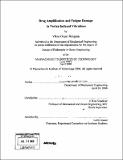Drag amplification and fatigue damage in vortex-induced vibrations
Author(s)
Jhingran, Vikas Gopal
DownloadFull printable version (46.03Mb)
Other Contributors
Massachusetts Institute of Technology. Dept. of Mechanical Engineering.
Advisor
J. Kim Vandiver.
Terms of use
Metadata
Show full item recordAbstract
Fatigue damage and drag force amplification due to Vortex-Induced-Vibrations (VIV) continue to cause significant problems in the design of structures which operate in ocean current environments. These problems are magnified by the uncertainty in VIV prediction, particularly with regard to fatigue damage. Although the last fifteen years has seen significant advancement in VIV prediction, important fatigue and drag related questions remain unanswered. This research addresses two important problems. The first is the difficulty in measuring local drag coefficients on long flexible cylinders, excited by VIV. At best engineers are forced to use spatially averaged drag coefficients. This is especially inaccurate when the pipe and flow properties change, either due to partial coverage with VIV mitigation devices, such as strakes or fairings, or shear in the incident current profile. The second problem is the lack of design procedures that account for the effect on fatigue damage due to the higher harmonics in the VIV strain response. To address these problems, two experiments were performed to collect data, the first in October of 2004 and the second in October of 2006. Both of these experiments were designed specifically to collect strain measurements from a densely instrumented pipe undergoing VIV at high mode numbers when subjected to current profiles with varying amounts of shear. Data from these experiments was used to develop a method to extract local drag forces from the measured mean strain. This method, when applied to a partially faired pipe undergoing VIV, successfully and accurately distinguished the dissimilar local drag coefficient between the bare pipe region and the region with fairings. In bare pipes, for the first time the method allowed for the measurement of the variation of local drag coefficient along the length of a flexible pipe undergoing VIV in sheared current. (cont.) Further by using filtering techniques, the higher harmonics were isolated and analyzed, particularly for their magnitude and phase response characteristics. Interesting features about the phase relationships between the first, second and third harmonics were observed when the primary VIV response was in the form of a traveling wave. Finally, data revealed some inaccuracies in the fatigue estimation techniques currently being used by the oil and gas industry. Two methods are suggested to incorporate the higher harmonics in VIV related fatigue design while correcting the observed inaccuracies in the current methods. The results revealed limitations in the commonly used, vibration-amplitude based methods of calculating local drag coefficients and may lead to modifications to correct these limitations. These findings also provide tools for researchers to include the higher harmonics in VIV related fatigue damage calculations and remove some of the uncertainty involved in VIV fatigue estimation and could lead to smaller safety factors in VIV fatigue design.
Description
Thesis (Ph. D.)--Massachusetts Institute of Technology, Dept. of Mechanical Engineering, 2008. Includes bibliographical references (p. 181-184).
Date issued
2008Department
Massachusetts Institute of Technology. Department of Mechanical EngineeringPublisher
Massachusetts Institute of Technology
Keywords
Mechanical Engineering.